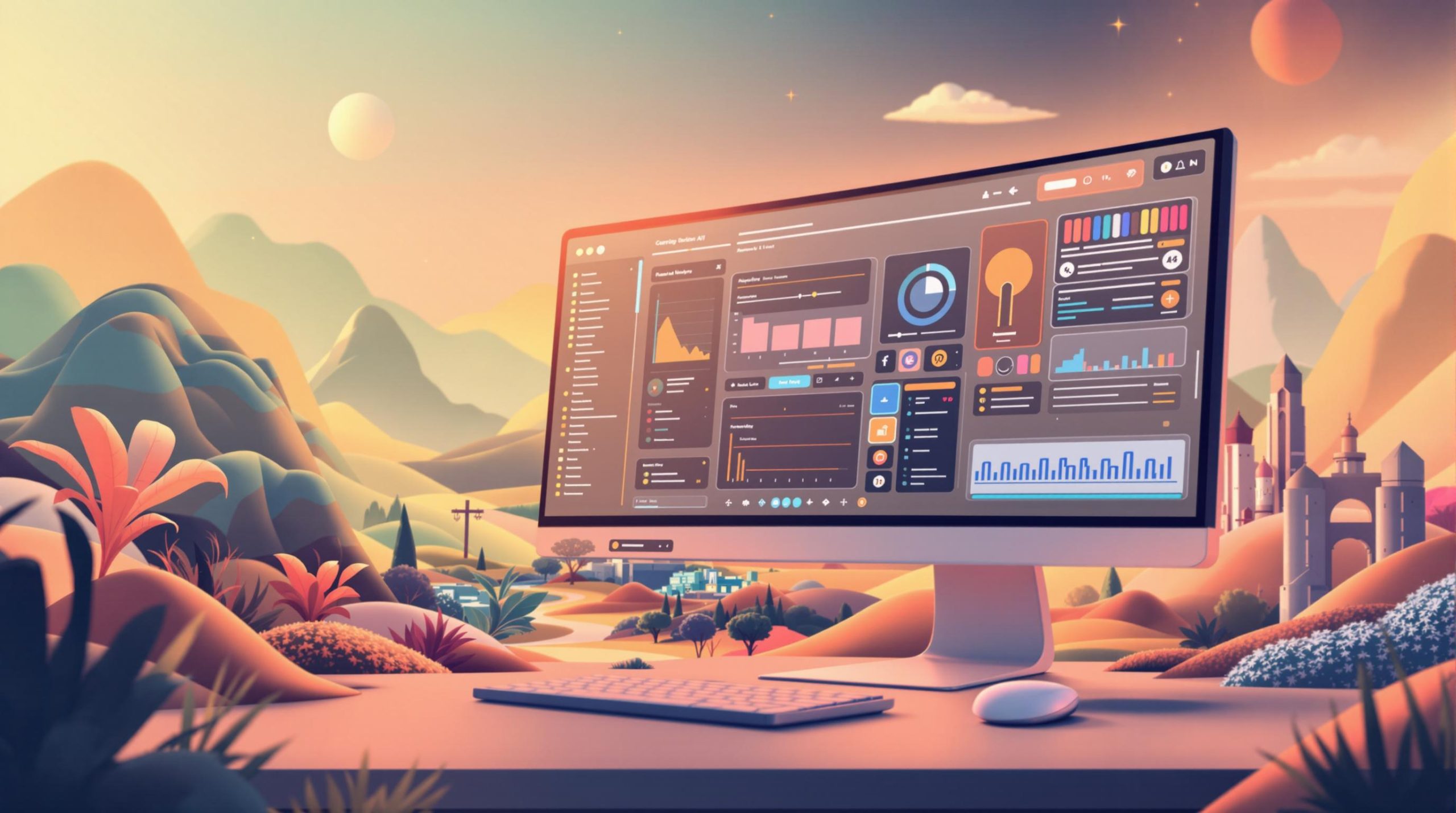Google’s Genie 2 and GameNGen are leading the charge by simplifying and transforming how interactive environments and games are created:
- Google’s Genie 2: Converts image prompts into interactive 3D spaces with physics and real-time lighting. Ideal for rapid prototyping and AI training.
- GameNGen: A fully AI-powered game engine that generates environments dynamically using reinforcement learning and diffusion models. It runs games like DOOM at 20+ FPS.
While both tools promise faster, more accessible development, they face challenges like high computational demands and scalability limitations.
Quick Comparison
| Feature | Google’s Genie 2 | GameNGen |
|---|---|---|
| Environment Creation | 3D spaces from images, diverse scenes | Dynamic spaces via diffusion models |
| Performance | 60-sec generation, real-time reflections | 20+ FPS, JPEG-quality visuals |
| AI Training | Diverse scenarios for agent learning | RL-driven gameplay mechanics |
| Scalability | Limited by computational power | Single TPU, 3-sec memory limit |
These tools are shaping the future of gaming with AI-powered creativity and dynamic, evolving content.
Google Just Changed Video Games Forever – Genie 2: AI Open World Games

1. Google’s Genie 2
Google’s Genie 2 is an AI-powered tool that turns simple image prompts into fully interactive 3D spaces, acting as a "foundation world model" [4]. This technology changes how virtual environments are created and manipulated.
Environment Creation
Genie 2 uses AI methods similar to those in text-based models to predict and generate future frames, transforming a single image into a seamless 3D environment. This approach helps developers quickly prototype environments from concept art or photos, cutting down development time significantly [5].
Interactivity and Performance
The generated environments come equipped with advanced physics and real-time lighting, allowing for dynamic interactions like jumping or swimming. Genie 2 also ensures scene consistency by accurately remembering off-screen elements and providing real-time reflections [4][6].
AI Training Applications
With its ability to create diverse environments, Genie 2 speeds up AI training by giving agents the chance to learn complex tasks in a variety of scenarios [6]. This has proven especially useful for testing AI agents in different settings, addressing a major challenge in AI development.
Scalability
By leveraging video data and advanced AI models, Genie 2 can generate diverse 3D worlds across different genres while maintaining consistent physics [4][5]. Competing with tools like World Labs and Decart’s Oasis, Genie 2 stands out in the growing market of AI world-building platforms [6].
Genie 2 is a prime example of how AI tools are making game development faster and more accessible. While it shines in creating environments and training agents, other tools like GameNGen show how AI can power entire game engines.
sbb-itb-5392f3d
2. GameNGen

GameNGen is the first game engine fully powered by AI, marking a new era in how games are developed. It’s not just changing game design – it’s reshaping the tools used to create them.
Environment Creation
GameNGen uses reinforcement learning to teach an AI agent how to play a game. Then, it applies a diffusion model to generate game frames based on the agent’s actions and observations [1]. This method eliminates the need for traditional game assets, allowing environments to be created dynamically.
Interactivity and Performance
The engine delivers some standout features, including:
- Real-time simulation of classic games like Doom at over 20 frames per second.
- Visual quality on par with JPEG compression.
- Consistent visuals throughout gameplay [1].
AI Training and Visual Consistency
GameNGen’s training process relies on reinforcement learning to understand gameplay mechanics, which then feeds data into its generative model. By using advanced techniques, it ensures the visuals remain stable and consistent during gameplay, even when correcting frame inconsistencies [1].
Scalability and Limitations
GameNGen isn’t without its constraints. It has a memory capacity of around 3 seconds, operates at 20+ FPS on a single TPU, and its visuals are limited to JPEG-level quality. It also cannot independently create entirely new scenes just yet [1].
Nvidia’s senior research manager, Jim Fan, has compared GameNGen to neural radiance fields (NeRFs) [8]. Beyond gaming, this technology could find applications in areas like professional training simulations and interactive educational tools [7].
Although GameNGen represents a leap forward, its limitations highlight the hurdles still faced by fully neural game engines.
Strengths and Weaknesses
AI-powered game engines like Google’s Genie 2 and GameNGen are changing the way virtual environments are created and experienced. By comparing their features, we can see how these tools are influencing both the creative and technical sides of game design.
| Feature | Google Genie 2 | GameNGen |
|---|---|---|
| Environment Generation | – Creates 3D spaces from images – Handles a variety of scene types – Limited to 60-second generation |
– Builds dynamic spaces with diffusion models – Simulates classic games in real time – Moderate visual quality |
| Performance | – Maintains visual consistency up to 60 seconds – Supports keyboard and mouse input |
– Runs at 20+ FPS on a single TPU – PSNR score of 29.4 – 3-second memory capacity – Includes noise augmentation for stability |
| AI Training | – Trains AI agents in various environments – Evaluates AI behavior effectively |
– Uses a two-phase training process with RL agents – Handles long, auto-regressive trajectories |
| Scalability | – Restricted by time-limited generation – Demands significant computational power |
– Operates on a single TPU – Constrained by hardware limitations |
GameNGen’s diffusion model stands out for delivering stable and realistic visuals, achieving a level of detail that human raters find highly convincing [1][2]. On the other hand, Genie 2 shines in generating interactive 3D spaces from image prompts [9][3]. However, its 60-second generation limit poses challenges for scalability.
Both engines face similar hurdles when it comes to computational demands and scalability. GameNGen achieves 20 FPS on a single TPU, but increasing complexity or frame rates would require more hardware [1][2]. Likewise, Genie 2’s powerful environment generation depends on substantial computational resources.
These comparisons highlight both the opportunities and challenges of AI-driven game engines, offering insight into their role in shaping the future of game development.
Final Thoughts
GameNGen highlights how real-time AI-driven game simulation is reshaping the gaming landscape. By generating environments and interactions based on player input, it reflects a growing trend in games that respond dynamically to players’ actions.
AI-powered engines are moving games away from fixed designs to experiences that evolve alongside players. This shift allows for gameplay that feels more personalized and interactive, as the game world adjusts in real-time to match player behavior.
These advancements aren’t just limited to gaming. The same AI technologies could transform fields like training simulations, adaptive learning tools, and immersive entertainment. However, as these uses grow, they bring up important ethical questions. Developers need to prioritize transparency, safeguard player data, and consider the broader implications of AI-driven systems.
Genie 2 and GameNGen showcase how generative AI is changing the way games are made. As AI models continue to improve, they will push game development toward a future where dynamic, evolving content becomes the norm. This paves the way for more engaging and tailored gaming experiences that grow and change with each player’s journey.

